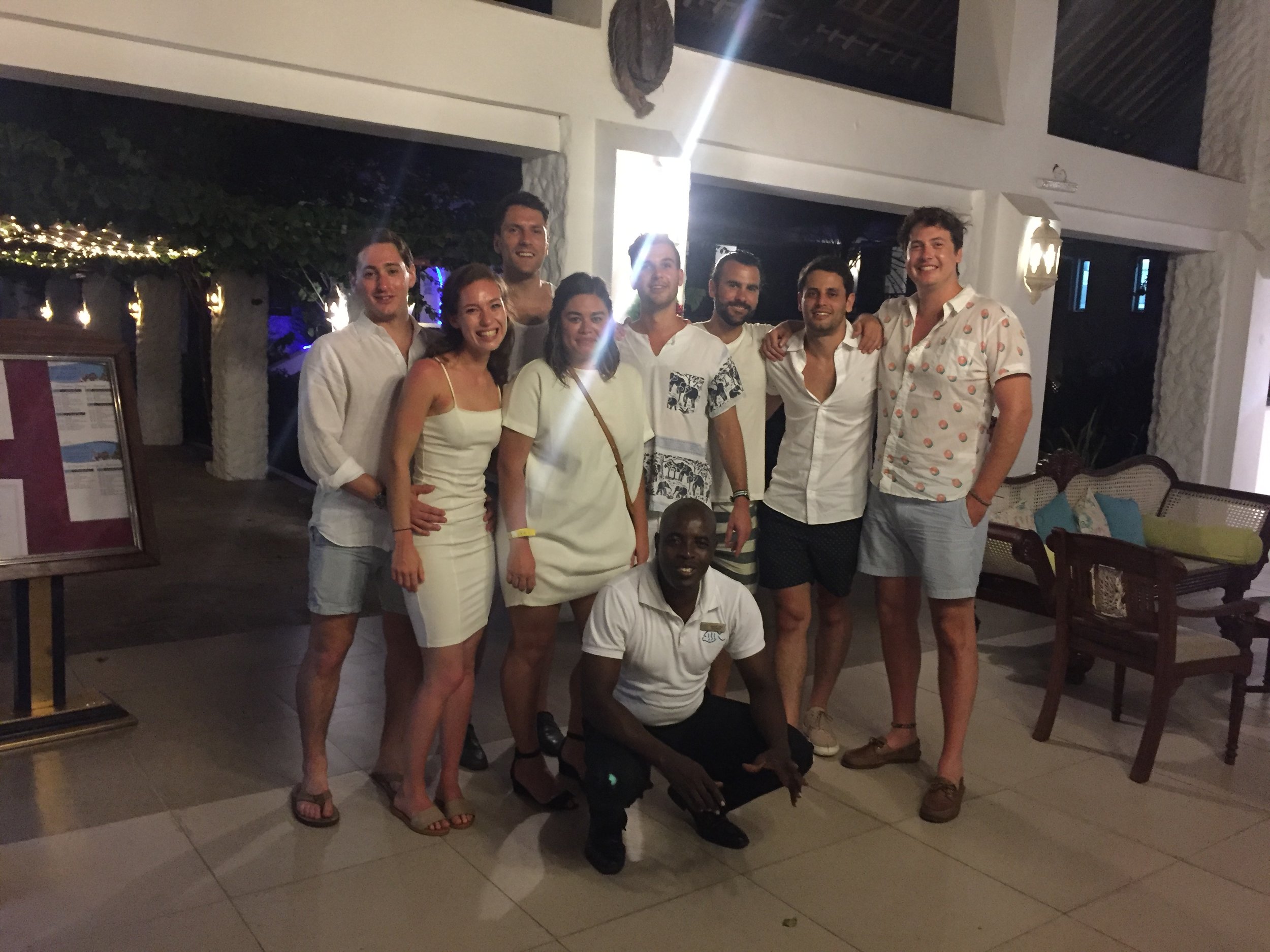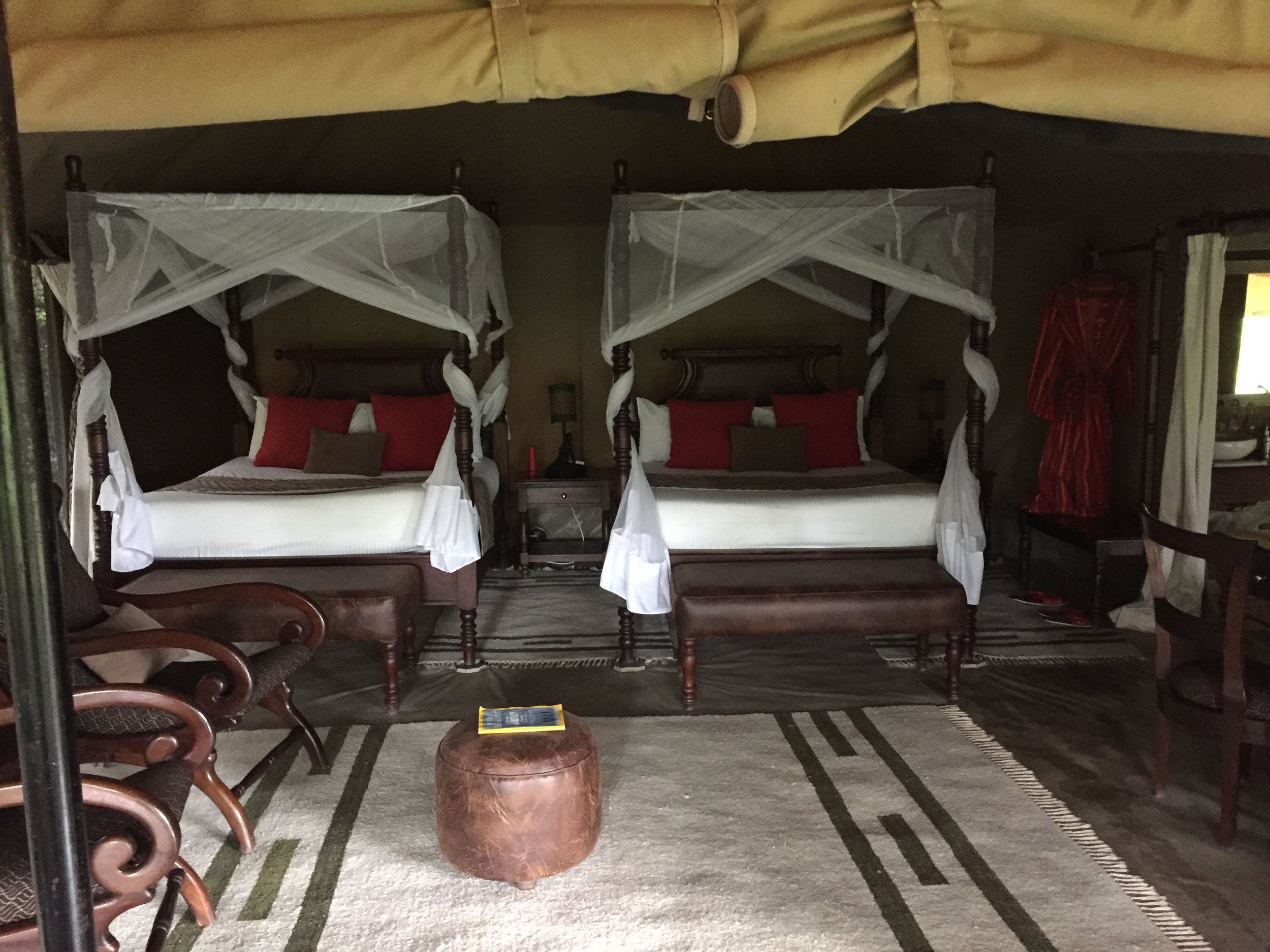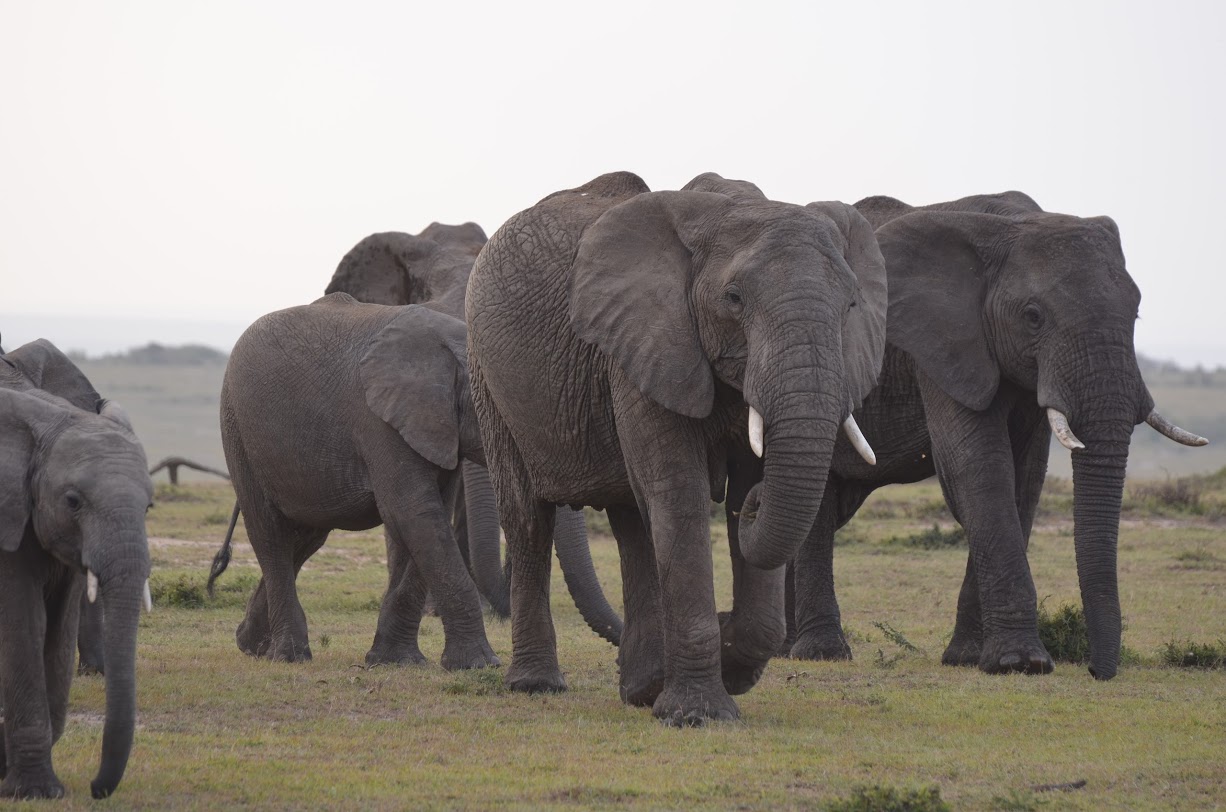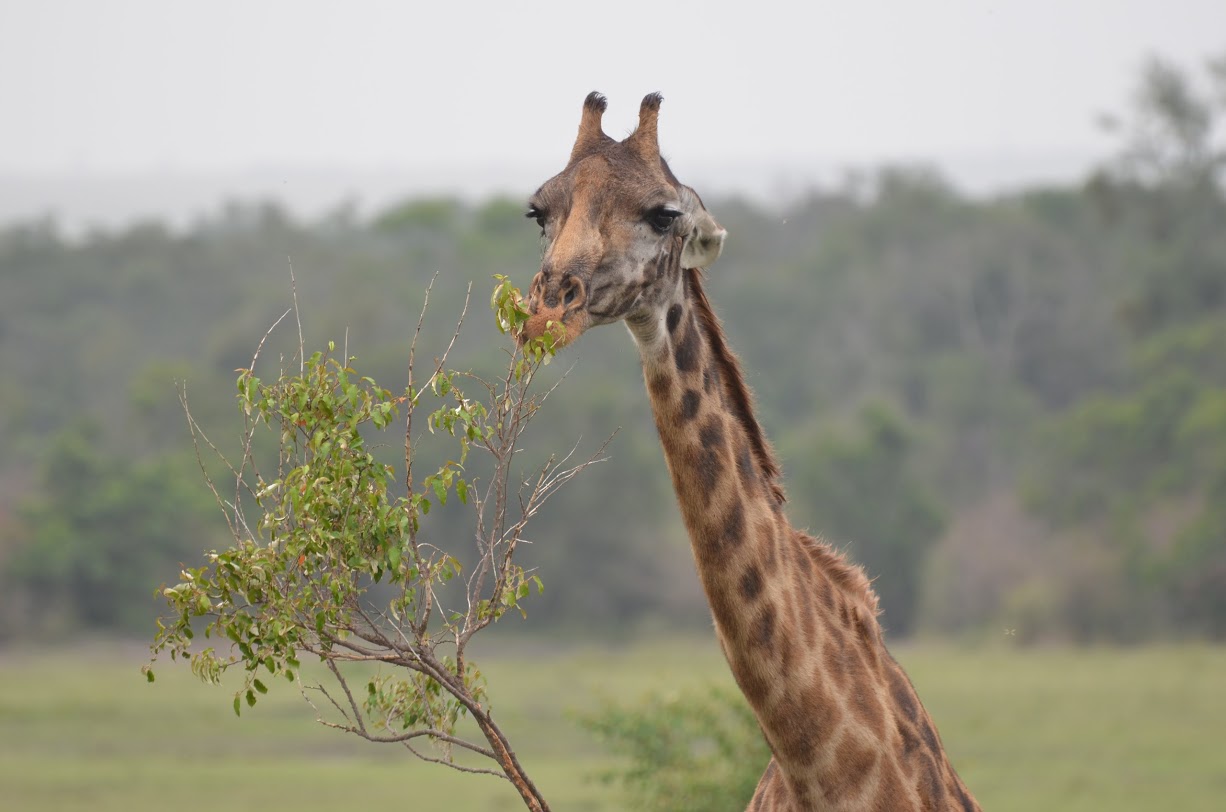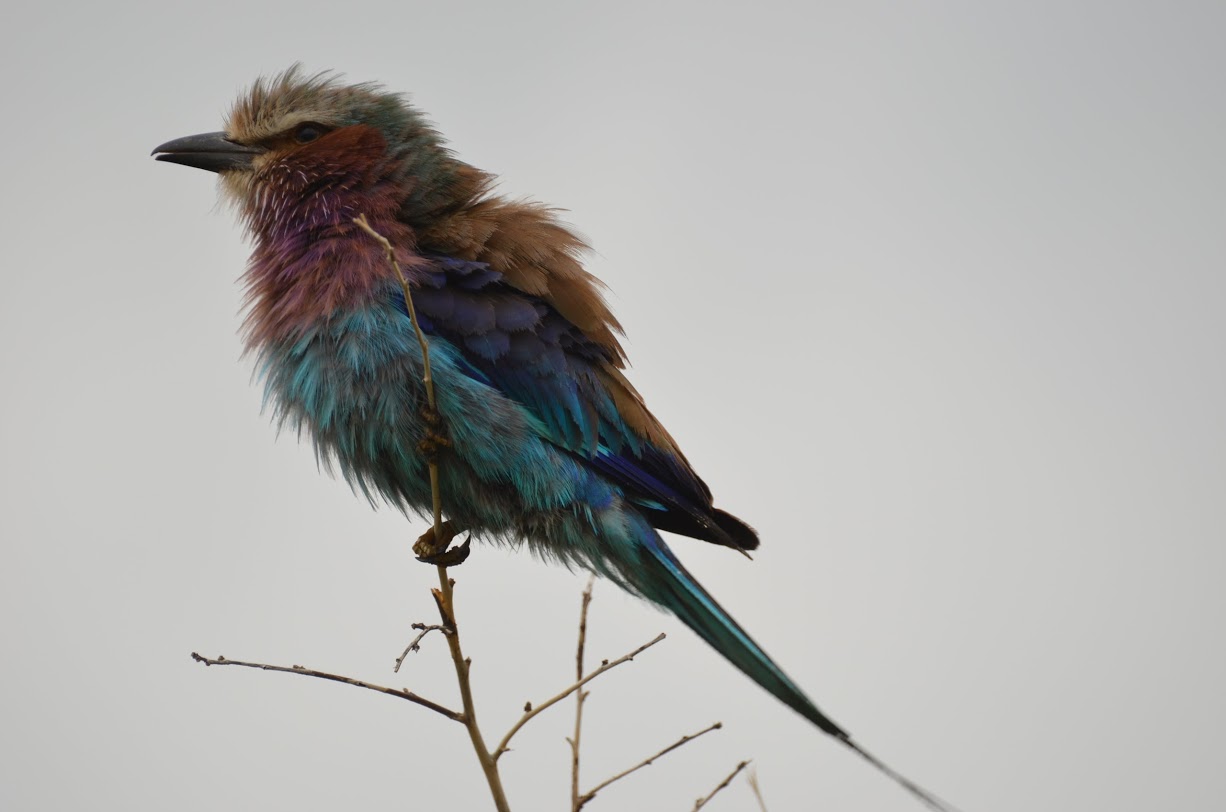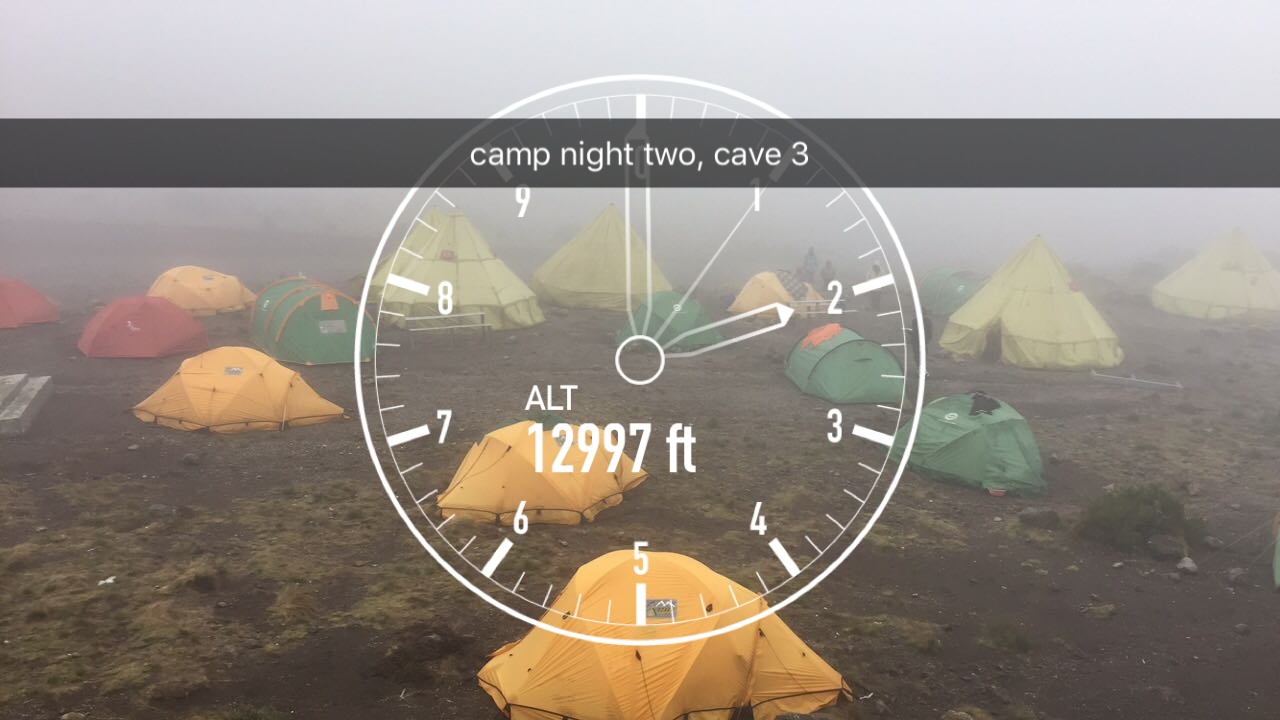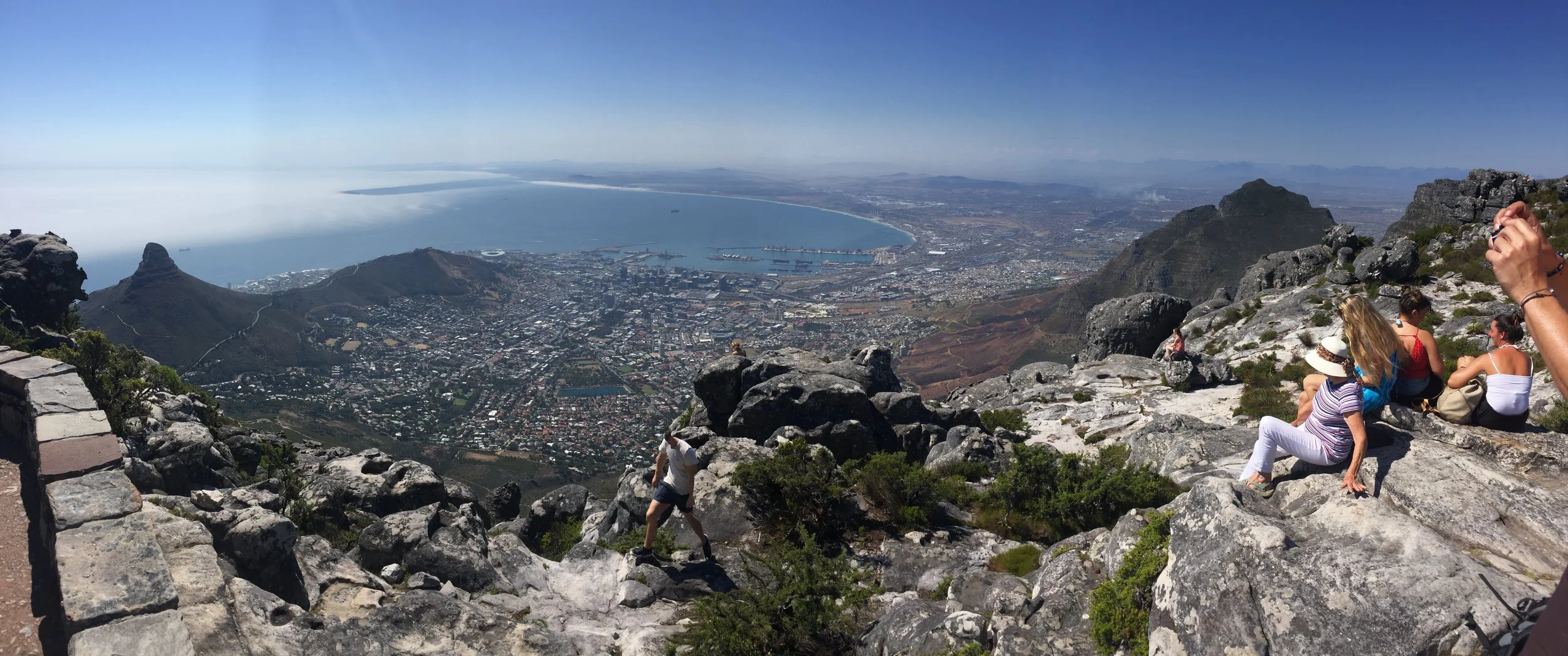the roof of Africa
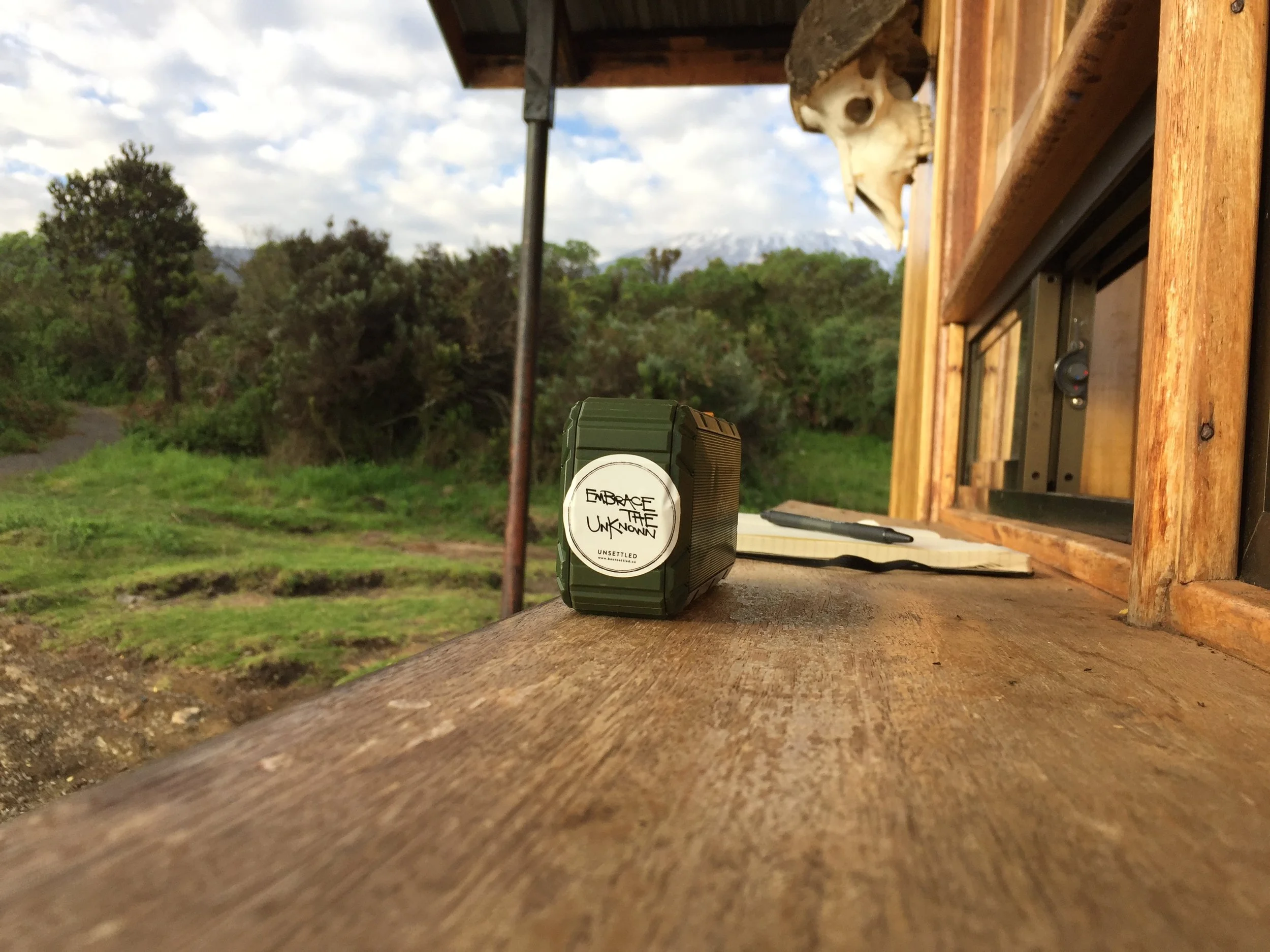
About 17,000 ft. above sea level, I started to have strong second thoughts about choosing to trek Kilimanjaro over 5 days during a late rainy season.
It had been about six months since I left Africa, and so naturally when my friend Kristy proposed a group trip to Kenya, shoehorning in a beach for New Year's, a visit to Nairobi, and a safari on the Maasai Mara, it was hard to say no. I had some business I had left unfinished in Tanzania in the form of a Kilimanjaro trip.
The mountain trek, due to a combination of poor conditions and rushed altitude acclimatization, ended up being a significantly more painful - albeit rewarding - experience than I had expected. During the first week in Kenya, conversely, the most difficult problem we found ourselves (frequently) forced to surmount was divining the provenance of our next gin and tonic.
Kenya
We began the trip at Diani Beach (the bottom right markers on the map above.) Known as the Indian Ocean destination for "Kenyan royalty," as my state department friend put it, Diani's beaches took me back to the east coast of Zanzibar, located only some 100 miles south.
Our first night in Diani Beach.
Diani's sandbars, glassy water, and wind make it an ideal destination for kitesurfers and skydivers, both of whom hit the beach on a daily basis. The scattered villas for beachgoers also make it a ripe target for scammers, as we discovered when the house we had booked on Expedia turned out to be a fraudulent listing. There is no level of excitement on-par with eight first-time Africa travelers realizing they have been stranded without a place to sleep. Fortunately, we were able to rely on the the family of our friend Qahir - from Nairobi - who would be joining us after Diani. But the people we did get the chance to meet there were all incredibly welcoming - culminating in a dance party on the beach at a small bar called Forty Thieves until the sun came up over the Indian Ocean.
Tuk-tuking back from Safari Beach Gym, which is a real place.
Our beach cafe at the Jacaranda Hotel.
While staying in Diani, I engaged in idle conversation with one of the housekeepers at the Jacaranda Hotel, a man named Hesbon. Talking about the new year, I mentioned off-the-cuff I hoped it would be better than the last, not expecting much of a response. He took the opportunity to give me a detailed glimpse into the Kenyan political situation.
The last year was very tough in Kenya. The current president, Uhuru Kenyatta, won a fraught victory against opposition leader and former prime minister Raila Odinga. However, in August Kenya's Supreme Court declared the election not validly conducted and mandated a re-election. When Odinga withdrew from the rescheduled election in October, causing a small crisis, rioting in the capital left some dead from political violence. The Supreme Court then reversed itself, declaring Uhuru the rightful winner, but by that time, the damage had been done.
According to Hesbon, who went into detail on the situation, the judicial court interfered where it shouldn’t have. All actors were only interested in gathering more power around themselves and their institutions, not creating better conditions for the people of the country. Now, the people would have to wait to see what Odinga would do in the new year (last week, Odinga swore himself in as "President" in a mock inauguration ceremony, suggesting that the unrest is not yet over.) In addition, repeated major road accidents in buses and trucks had left many on Kenya's highways dead in the past year, leading the country to ban all public travel at night. Hesbon, who teared up when talking about it, was hopeful but discouraged about 2018.
Uhuru is the son of Jomo Kenyatta, the anti-colonial activist who led Kenya as its first president from 1964 to 1978. (Odinga himself is the son of the former vice president, Jaramogi Odinga.) Though Kenyatta's presidency has been seen as widely successful, creating a stronger and more prosperous Kenya as the leader of the East African Community trade and cooperation group, he is not without controversy. In particular, he is wanted by the International Criminal Court for funding political violence in the 2007 elections that left 1,300 dead (before his presidency began in 2010.)
Team Kenya Dig It and Charles get ready for new years' eve.
Can confirm.
Overlook of the Great Rift Valley.
Africa: Brought to you by Coca Cola.
On our way into the Maasai Mara, the only road in washed out the night prior.
We had to wait an hour for a construction crew to dig a road around the bridge that had collapsed.
No traffic jam is too dire to get some couples shots for the gram.
From Diani, we drove to Mombasa, a big port city situated on an island in the delta of a cool bay, and made our way through downtown to the airport. There, we met up with our guide for the next week in Kenya, Kristy's friend Qahir, who works with her in San Francisco and whose gracious family hosted us in Nairobi and the Maasai Mara.
Heading into the city from Nairobi airport (named for Jomo Kenyatta), our driver gave us more background on Kenya's unique situation in east Africa. The country has an on-off warm relationship with its neighbor Uganda, an economic partner but one under the unending leadership of the unpredictabel Yoweri Museveni, president since 1986. In the north, the terrorist group Al Shabab (related to Al Qaeda) infrequently raids across the border from Somalia. Because border control is weak, and there are many ethnic Somalis in northern Kenya, it is hard to isolate them and keep them out. The last raid, at the Westgate Mall in 2013, 67 and injured 175 people at a mall targeting the UN office there - the only UN branch, apparently, headquartered in Africa.
Generally though, according to our driver, Kenya, as the leader of the EAC, has a good relationship with its neighbors. Chinese are now flooding to Kenya en-masse (something I had noticed in Tanzania as well) to build everything from bridges to buildings to roads. They outcompete all others for contracts - including local Kenyan firms - and undercut their pricing by (allegedly) using prison labor, importing political prisoners from China to do the work for free.
The Chinese who come, according to the Kenyans we talked to about it, don’t do much to assimilate. They're rumored instead to spend their free time an money gambling and clubbing. They learn Swahili, which is interesting, but apparently refuse to learn English. According to our driver, Kenyans generally like English and the English education system, and have a positive relationship with it as their "internationalizing force."
After a generous dinner hosted by Qahir's family, we took off in the early hours of the morning en route to the Maasai Mara for safari. The Maasai Mara - called the Serengeti in Tanzania - is made by the Great Rift Valley that runs 3,700 miles from Mozambique to the Red Sea. Nairobi is on a temperate plateau, from which you dive down into the valley to get to Maasai Mara. Along the highway, which is a road built by captured Italian POW's from the Ethiopian colony during WWII, we pass a small Catholic church built also built by those POW's for those who died building the road.
One of many small towns we pass through on our way into the Mara.
Scotty and I avoid Maasai trinket-sellers while picking up some beers.
Doug is not so lucky.
We also passed a protest on the highway of men waving sticks. They look happy, but chant and carry signs that say “Chinesse [sic] go home”. Along the way, you see the same small dusty towns with cinderblock buildings, rusted shops, and tin roofs that I had seen so many times before taking buses from Zimbabwe through Malawi. Some of them still inexplicably say “equities” and “investment opportunity” on the side, but they are mostly barbers, butchers, chemists (pharmacies), and general stores. A small community mall we drive through plays an important purpose - a market takes place twice a week, the only time that most have access to purchase basic goods and trade gossip. The rest of the time, it’s quiet.
Below are some of my favorite shots from the safari, most of them courtesy of Joel, Qahir, and James who were taking the action shots.
For the safari jetset, flying into the Mara is always an option.
You up?
Your standard, run-of-the-mill Maasai Mara safari acommodations.
Little touches for a personalized safari experience really seal the deal.
If Joel's photography career ever takes off, it will be from this Nat Geo submission.
A good idea of how little the animals care about trucks of safariers.
Most photos courtesy of Joel Silverberg, Qahir Popat, & James Bozanich.
On the Mara, we are led for three days by Qahir's family friend, Tom, who is of the Maasai tribe. He grew up as part of the nomadic group, never attending school and living the life of his rural pastoralist family until he started to work in the nascent hospitality scene for traveling safari-goers. In that line of work, he met Europeans and Americans who insisted he come visit them, eventually taking one up on an offer to go to Detroit.
Tom - who had never seen snow before - made it to New York and Detroit in the dead of winter, wearing nothing more than the traditional Maasai Shuka he came in. He told us his "coming to America" stories, some of entertaining but maybe apocryphal origin, including trying to microwave his phone to dry it off and being detained by shopping mall security for carrying his stick and machete.
Team Kenya Dig It and the unstoppable safari mobile.
He also told us about the Maasai rites of passage that he went through, including ear laceration, removing his two front teeth, and public circumcision. All of these are routine in the coming-of-age of a young Maasai man, and any sign of emotion or tears during these ceremonies is seen as a weakness that can come back to haunt young men for years afterwards. The final rite, rather than a bar mitzvah, is that of going into the bush alone with nothing but a spear, and having to kill an adult male lion to remove its mane. The Maasai are the last people in Kenya allowed to kill lions.
How you get around when there are high rains and road washouts.
Mara river overlook at our second camp.
Qahir and Tom deliberate how the hell we are going to get across this river.
Their culture includes as its pillars monogamy, respect for elders (young men and women are expected every one in a room personally and tell them which family they come from) and female genital mutilation.
The Maasai use their distinctive ear lacerations and red clay as a way to identify themselves apart from others and prevent internecine war. As a way of identifying themselves personally, rather than tribally, they each wear distinctive earrings within the broad holes.
Tom now works as the host and owner of a series of Maasai Mara camps - at which we stayed - and was formerly an international ambassador for the tribe. As the Maasai ambassador, his travels took him from China to Geneva for a UN conference on indigenous people.
This jaguar had a bloody neck from fighting another jaguar.
On our last day in Kenya, in Nairobi, we were again hosted by Qahir's generous family, who invited out extended family members and served us a large banquet. I got a chance there to catch up with my old friend from college - who went by his British name, Wilson, at Stanford but had since moved back to Kenya to make a foray into politics and re-adopt his Kenyan name, Kanyi - and meet his wife. The group took us out to one of the many outdoor expat clubs in Nairobi's thriving nightlife scene to enjoy our last night, before I woke up at 6am to catch an 8-hour bus to Moshi, across the border in Tanzania.
Passing through a local market on the way back.
Rush hour.
Kilimanjaro
I traveled to Moshi, the second leg of my trip, as the rest of the group flew to the second leg of theirs in the Seychelles. On my backpacking trip through Africa six months ago, I had made it into Tanzania and taken the Tazara railway across the south of the country from Mbeya to Dar es Salaam. However, I had chosen to go see Zanzibar instead of traveling further north to Arusha and the Serengeti, and never got a chance to see the famous Kilimanjaro. That is why, partially inspired by a friend's roommate in New York who has just hiked it, I decided to return to it.
Moshi is a small town on the southeast corner of Mt. Kilimanjaro. To get there from Nairobi, one takes an 8-hour bus across Kenya's "most dangerous highway" (complicit in the bus crashes mentioned above) across the Tanzanian border and through the larger commercial town of Arusha. Moshi and Arusha are both spectacularly beautiful towns - tropical and lush on the equator, yet on a raised plane that makes the heat tolerable. I arrived at Moshi and repacked my bags, ready to start my Kilimanjaro trek the next day.
A small town in the foothills of Kilimanjaro.
The base of the mountain, unlike the rest of it, is still tropical.
As it would turn out, I ended up picking a fairly disastrous week to hike Kilimanjaro. As I found out in Nairobi, the night before I was due to take the bus down, that there had been late January rains in the Sarengeti (the same that hit us in the Maasai Mara) which had dumped snow on Kili. It was the most January snow the mountain had seen in 15 years.
Kili is not a technical route, which is why I call it a trek and not a climb. Hiking poles help, but apart from that, no gear (crampons, belays, ice picks) is needed to get to the top. The oldest person to summit Kili reached the top at age 85. Thousands make it up every year (my certificate listed me as #399,489 to make it to a peak on the mountain.) So the mountain itself, even though it is one of the Seven Summits and the highest in Africa, is not particularly daunting. It is fair to say I underestimated the mountain.
I would give myself a 7/10 for my first Seven Summit attempt. In case it can be helpful to future hikers, here are some notes on the trek, what went right, and what went wrong.
A man shows off his pet chameleon.
Waterfalls on the way up the mountain.
My hotel at Moshi.
Rongai is one of the few routes to start from the Kenya side.
What went well
- Dressing for cold weather: The top of the mountain, starting around 16k ft., was well below freezing. I never felt cold on summit day*, mostly because I was wearing:
- 3 pairs of socks (2 wool) and hiking boots,
- 4 layers on my legs (jeans, underwear, shorts, hiking pants),
- 5 layers on my upper body (including my Patagonia wind-proof, water-proof shell jacket - still the best purchase I've ever made),
- A balaclava, earmuffs, and wool cap.
- (*even though I had rented alpine gloves and liners from the tour , my fingers froze at the top and I had to switch gloves. A week later, I still don't have full sensitivity in some of the tips of my fingers.)
- Eating: It's really hard to eat at altitude. Your mouth goes dry and you never feel naturally hungry. The night before the summit climb, I had to feed myself pasta to carbo-load by chewing cold noodles and then swigging two thermos' of water to be able to swallow.
- Water: Water makes all the difference during the hike, and this is especially true on the summit attempt, when you'll be stopping to rest somewhere between 20 and 100 times. I brought two full nalgenes up to the summit with me.
Sunset over our first night's camp site.
You see the beautiful Mawenzi peak when ascending the Rongai route. It is now closed to climbers.
Porters run bags and tents up and down the mountain.
Room for improvement
- Pacing: Trekking Kili alone had one advantage and one disadvantage on summit day. The benefit was that, if I had been with friends or in a group, we probably would have turned back. I had one guide and a guides' first priority is always to guide hikers down from the summit. On our ascent up the mountain at 2am, we saw countless groups and individuals who had turned around, hiking back down with their guides. The drawback was that, as a group of two, my guide and I could move much faster. The summit ascent and descent is normally supposed to take 10-15 hours (which other groups stuck to), and we did it in 7. I was the one constantly imploring my guide to take a break - we stopped 50+ times so I could catch my breath - but we still moved too quickly. The fast rise - 4.5 hours from 15k ft. to 19.5k ft. - meant that I got absolutely destroyed by altitude sickness.
- Food for the climb: I asked friends for advice before traveling to Kili, and I don't know why I didn't pay more attention to the sage advice to bring energy bars for the summit. Instead, I had a small box of cookies. Protein bars on the hike up would have made a world of difference.
- The route: The Rongai route summits Kili from Kibo Hut, our base camp at 15k ft. The climb from there starts leniently enough, but pretty soon turns into a steep scramble over rocks, scree, and snow, with about 45 minutes of vertical climb to reach the cornice of the Kibo caldera.
What went wrong
- Conditions: If I ever hike Kili again, I am going to make one big change: go as far away from a rainy season as I can. It rained or snowed at least once every day of our hike. Our summit attempt started off in beautiful conditions - clear skies and no wind - but we could see the clouds chasing us up the mountain as we climbed. By the time we came over the cornice at Gilman's Point, we were in 20 ft. of visibility. By the time we got to Uhuru, it was snowing. And for the traverse between Gilman's, Stella Point, and Uhuru, we trudged through 2-3 ft. of snow, which turned what is normally a 45-minute traverse into 1 1/2 hours of slow marching.
- Sleep: I slept under two hours the night before the summit attempt. This was not for lack of effort! We ate dinner at 5:30 and went to bed around 7, but sleeping in a tent - at the exposed Kibo Hut - did not help. High winds rag-dolled our tents from 7 until about midnight, when I passed out. At 2am, our alarms went off and we got up to hike the summit.
The view from my tent's "patio," under the rain cover.
Our second campsite: higher up in the tundra and clouds.
The main mountain that Uhuru Peak sits on top of is called Kibo.
Mawenzi Peak.
Waking up on day 2, Kibo had been hidden behind the clouds.
The journal I kept while on the hike, as well as my packing list, are below:
Packing List Day pack Osprey Backpack Wicking t-shirt Long sleeve shirt Patagonia jacket Sweatshirt Wool hat Balaclava Hiking boots Wool socks Playing cards Plastic bags / zip locs Bandana Money ($400) Batteries Notebook / pen Dry towel Solar-powered accessory USB charger Diamox Protein bars Hand / foot warmers Sleeping bag Sleeping pad Swiss army knife Gatorade / hydration drink mix Iodine tablets Chocolate for village children, mementos for guides and porters Toilet paper Trekking poles Hiking pants Long underwear Gloves 2x Nalgene Camelback
Visibility on most nights was about this good.
The Dream Team: Elias, Geoffrey, Ramadan, Paolo, and Wilibard.
Day 1: Tropical to Temperate Mountain Forest; 3,000 to 9,000 ft.
Wardrobe: Shorts, hiking boots and socks, wicking shirt.
- The first day's climb saw us drive up from Moshi, at 3,000 ft., to the trailhead of the Rongai Route at 6,000 ft. and begin climbing. We made camp at Simba Camp, at 9,000 ft. It's hard to believe we were so high, but this was 9,000 ft. at the equator, where we could still walk around in shorts.
- I carried my own full pack and waters the first day. We are expected to carry up only a daypack, but the last porter wasn't scheduled to come up until later, so I carried mine. It was nothing. The "4 hour" hike only took about two. The guides nicknamed me Mlima Simba - mountain lion - for scrambling up over the hill and passing porters. We'll see if this first day's hubris amounts to pain tomorrow.
- Our team - the guides adopted the '92 Dream Team name - consists of myself, Wilibard the guide, Elias the cook, and three porters, Ramadan, Paolo, and Geoffrey. Wilibard is quiet but opens up after a while. Elias is a born extrovert, always singing reggae. Ramadan's English isn't enough to be chatty, and Geoffrey the youngest one is usually pretty quiet as well.
- The camp, even though it is simple, is almost uncomfortably bourgeois. My tent is the biggest, with an actual tent area and a small covered patio in front with a table and chair, coffee, tea, spreads, and toppings for meals. When you reach and make camp, the cook makes you tea, then a basin to wash, then dinner.
- I've always been a bit uncomfortable with being waited on. I've been teaching myself Swahili to better talk to the team. I help them pitch the tents and eat with them. I connected my guide, Wilibard's phone to my bluetooth speaker, which they love. I'm reminded of India, when in Jalandhar all the staff and servants would bow and usher me through doors, and I'd insist on going after them. But to people used to serving, such deference is anathema to what they expect. Still, I'll never be comfortable with people prostrating themselves before me.
- Today, when running back to give a little girl my chocolate (they expect this from all the hikers as a toll; it's a complete racket), I saw the last porter coming up with our bag on his head, so I told him to let me carry it, and balanced it (with one arm) on mine until we got to the junction. All the vendors and people milling around at the little market nearly fell over themselves laughing and taking photos.
- The week prior, Kilimanjaro got the most snow it's had in 15 years apparently (in the dry season, no less.) It'll probably be cold, but I think I can handle it. The altitude sickness is what I worry about the most. This luck is not new to me. I remember, backpacking in Asheville on the AT as a kid, it got the most rain of anywhere in the US while we hiked. We slept on ground tarps, with no tents and nothing overhead but another tarp above us. Seems to be my luck. I have fond memories now, but I also remember being miserable at the time, sleeping in mud every night, wet.
Wilibard my guide following behind on the trail.
Day 2: Temperate Forest to Moorland; 9,000 to 12,000 ft.
Wardrobe: Boots, shorts, shirt, fleece cover, windbreaker.
- The sign at Simba Camp says it's 18 hours up to Uhuru Peak from here - about 10,000 ft. of climb. That would be one stressful day of hiking, but it's not possible in one day without getting altitude sickness.
- Today we're supposed to hike to Second Cave (3 hours and 8 km), and sleep there. Yesterday, we made a 4 hour hike in 3 hours. At this rate - we woke up at sunrise - we'd get there for lunch and sit around all day. I've asked our guide for us to continue on to Third Cave today (another 10 hours and 11 km.) It's not advised to go too quickly, but the weather is beautiful this morning (you can see the mountain for the first time) and I want to get higher up to have longer to acclimatize. That way, in case it rains tomorrow morning, we can delay hiking. The 17 Germans camped next to me are making the entire trek in 5 days. They hike in a retinue of porters, cooks, and guides that brings their total group to 60. The sun feels great; maybe our luck's changed.
- Today is the highest I've ever been on land, at 12,000 ft. To put the peak in context, Uhuru is 500 shy of 20,000 ft. We did one of the highest possible commercial skydives a few years ago at 18,000 ft.
- The hike here is mostly up. They don't make much use of trail switchbacks on Kili like they do in the US. And those that they do have are shallow. This makes the hike tougher but faster. The Simba to Second Cave section was supposed to be three hours; we made it in about 1:45.
- The weather changes quickly up here. We made it to Second Cave at 10am and I had my shirt off, wearing just shorts in the sun. An hour later, the clouds and wind brought winter weather and I was back in my wool hat.
- We made it to Third Cave around three, after taking off from our lunch at Second Cave. As I feared, the rain caught up with us on the way to Third Cave. It started mildly, but rain can move up the mountain faster than people can. By the time we hit Third Cave, it was pouring. I had covered my bag with my waterproof parka, but I threw it into a cave to keep it safe. Then I got to work with the porters for the big German group, who had already made it up. Thankfully, some backpacking growing up taught me enough to be helpful. That was probably the most fun part of the day, running around with the porters putting up the big communal tents for the other group, and then mine, in the rain. It's simple to put up a tent here - grab a line, grab a stake, grab a rock, and drill the stake into the ground. If you run out of stakes, just use a big rock for the line.
- "Hiking Kilimanjaro solo" is a big misnomer. I thought it would be me and a guide, maybe a porter. The tour group assigned me one guide, three porters, and a cook, and apparently it would have been four porters if I hadn't insisted on carrying my own stuff.
- The altitude crushes your appetite. I have to keep telling myself how important it is to overeat when I don't want to.
Day 3: Moorland to Arctic Tundra; 12,000 to 15,000 ft.
Wardrobe: Pants, leg covers, wool hat, boots with 2x socks, long underwear shirt, long-sleeve wicking shirt, fleece.
- We woke up in the morning after a night of rain and everything had frozen over. It was way colder than when we went to bed. I threw on some extra layers and went outside to see the sun about to rise and, behind us, where yesterday had just been a cloud, Kilimanjaro.
- Today I decided to change my mentality from 'climbing strong' to 'climbing smart.' I still haven't gotten altitude sickness (I'm sure I will tomorrow), but each step is harder, especially up, so you have to move slower.
- Today I started setting small goals instead of just thinking about the end destination for the day. 20 ft. and rest, just past that rock and rest, etc. It was the first day I thought twice about choosing to carry my backpack.
- I let the porter, Geoffrey, and then Wilibard be the pacemaker most of the way. We still made it between camps in about 2 1/2 hours.
- We saw the clouds chasing up after us as we hiked, but managed to stay out of danger and got to Kibo just in fog (not rain.) About half an hour after we made camp, it began to hail.
- Correction: the hail and sleet has now turned into a steady downpour of snow (around 1pm.) Kibo Camp, which is full of tents, is deserted, as everyone has taken cover. Now there's nothing to do but sit, wait, and rest. The porters are great about boiling a thermos of hot water to slowly drink with every meal. I'm in my sleeping bag now drinking hot water and reading my book.
This was my tent on the night of the summit ascent, at Kibo Hut "base camp."
"Muzungu porter," lifting the heavy load that porters carry up the mountain on their heads.
Day 4: Arctic Tundra to Summit; 15,000 to 19,500 ft.
Wardrobe: Boots, 3x socks (2 wool), underwear, shorts, regular pants, hiking pants, short-sleeve wicking shirt, long underwear shirt, long-sleeve wicking shirt, fleece, parka, 2x gloves, wool hat, balaclava, earmuffs.
- The summit was brutal. I did not expect it to be nearly as trying as it was - it was without exaggeration the most pain and exhaustion I've ever felt.
- We started our ascent at 2am. Groups began leaving around 11pm for the hike, but Wilibard was adamant about sleeping until 2, even though I strongly wanted to leave earlier. He ended up having a good point. Still, the sleep was as bad as it could have been - high winds whipped our exposed tents all night and I got maybe 2 hours of sleep between 7pm and 2am. Yet when our alarms went off and Elias came over with the tea, the winds had died and we were under a completely clear night full of stars. I took my Diamox and got dressed.
- The conditions were as good as they could be at 2am, so we set out. As we started hiking from the Kibo Hut base camp, we could see groups of hikers in the distance, marked by their headlamps, ascending up the mountain.
- The summit hike is a straight shot up the side of the Kibo caldera at the top of Kili. The first portion is a straight path, followed by some steep switchbacks up the side of the caldera, and at the end about an hour's scramble over steep rocks and scree before coming over the cornice to Gilman's Point, the first peak on Kibo.
- As we hiked up, watching the headlamps above us, I saw a couple shooting stars in the clear night.
- Some of the headlamps were brighter than others, indicating that they were pointed towards and not away from us. On our route, we began to run into groups that had turned back, small packs of hikers silently descending with their guides. This was the first sign that we may run into trouble.
- A big benefit of going up with just a guide (the rest of the team stayed down at Kibo Hut) was speed. We could jet up the side of the hill. On our way up we passed many larger groups of hikers slowly ascending. This was helpful at first, but ended up hitting me hard around 17,000 ft. At that point, I began to feel serious exhaustion. Before too long, I had to pause to catch my breath about every 20 to 30 steps.
- We kept passing groups of hikers coming down the hill from turning around. And as we got up to the scree and steep rocks, looking up to the cornice, the weather finally caught up with us. Snow covered the ground and the fog killed visibility to about 20 ft. By the time we came up to Gilman's Point - around 19,000 ft., I was chronically out of breath and began to feel severe dizziness.
- Once you summit Gilman's Point, the hike becomes easier. You have to traverse from peak to peak on your way to Uhuru. It's a pretty flat walk from Gilman's to Stella Point, and then up. The traverse normally takes about 45 minutes, but when we summited we encountered three-foot deep snow that killed our hiking time, having to carefully watch each step and find the packed snow. It took another hour 30 minutes to reach Uhuru.
- Getting to Uhuru was the most hollow victory I've ever felt. By the time we made it, I was still dizzy and completely exhausted. As I crashed down onto a rock to catch my breath, there was nothing I could think of as disheartening as the fact that we would now have to repeat that same exact route moving down. We took a quick photo and turned around in less than 5 minutes. Of the other climbers who made it to Uhuru were a New Zealand girl I met and a 12-year old kid with his dad from SLO.
- The descent was as brutal as the way up. My fingers froze through and I had to switch gloves with Wilibard (a couple weeks later, I still didn't have sensitivity in some of my fingertips.) In possibly my lowest moment, while trying to call out Wilibard's name (which I'd been doing every minute to take a break), I couldn't remember it for a good 30 seconds due to oxygen deprivation and altitude sickness. It was at that point I realized I needed to get off the mountain.
- I began to walk on autopilot, focusing on keeping one foot in front of the other. My mind went completely blank at this point. We made it down the mountain in only about 2 1/2 hours to the 4 1/2 hour ascent. The hiking poles, which I'd never used before, helped tremendously.
- A group of Germans made shirts that said "Kili 2018: Let's Do It."
Day 5: Moorland to Tropical Forest; 12,000 to 3,000 ft.
- Right now, I'm in a sleeping bag in a little ski chalet-type house in Tanzania, having just hiked the summit, reading a book in a tie dye bandana and my California Chubbies. I'm still completely, unfathomably exhausted, but we make it down to the base today and life is as it should be.
- The best advice I could give is: 1) take energy bars up, 2) carbo load, 3) go slow, 4) sleep well the night before, 5) go during the dry season, 6) wear warm, waterproof clothes, 7) take Diamox!
A typical meal from Chef Elias.
Post-Script: The Way Back
Upon coming down the mountain to once again get on wifi and connect with the outside world, I found out that my flight home had been canceled. Two days before I was due to travel to New York. After a couple hours on the phone with an unhelpful customer service - at the appropriately named CheapOAir - I booked a flight on the spot and traveled through five countries in 30 hours - Tanzania, Kenya, Chad, Morocco and the US - to get home.
Taking the bus back up to Nairobi from Moshi, I was packed in alongside budget safari-goers and the Peace Corps / community service set of young college-graduate idealists who come from the US to work in Africa for two years. It made me realize, listening them, that we do send children to be our ambassadors from the US in international diplomacy. This is not a critique or a negative, but it was interesting to hear these teachers and nurses discussing binge drinking in bars in Arusha the same way they would at Boston College, or an older lady patronizingly mentioning to her husband how locals throw trash on the ground "because they don't know any better." It makes me think we still have far to go in really bridging the gaps to understand each other across borders.
- Nik / 1.28.18
On my last night, I took the bus from Moshi back into Nairobi for my flight. There, I met up with my friend Paloma, who works out of Nairobi in Nigeria, Sudan, and Ethiopia for the State Department. At left, she takes me out for a local fish meal at a rooftop bar. At right, N'Djamena airport in Chad, where my impromptu flight home had a pitstop to refuel, because the oil is cheaper in Chad than in Morocco.







